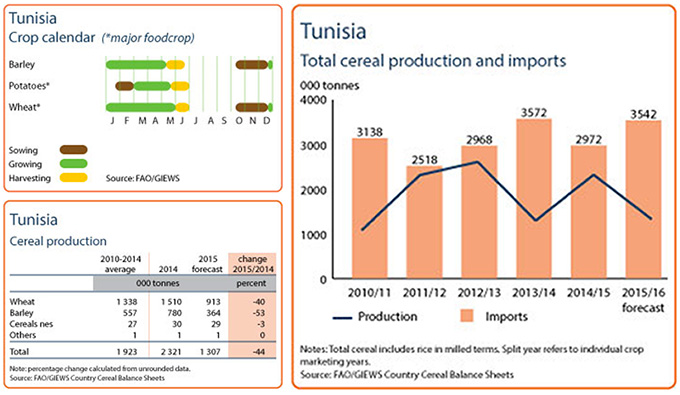
Earlier this year, the Food and Agriculture Administration (FAO) of the United Nations reported that wheat constitutes 96% of cereals consumed and over half of the daily caloric intake per person in Tunisia. What’s more, the high demand for cereals, and by extension cereal imports, are projected to rise in the years to come. In measure with these findings, statistics recently published by the Ministry of Agriculture for the 2014-2015 seasons report above-average imports; meanwhile, market speculations for 2016 anticipate that cereal imports to Tunisia will be up 15% from the previous five-year average.
A double-burden: malnutrition by excess and deficit
Prompted by the FAO’s observations to get a more detailed picture of cereal production, consumption, and imports in Tunisia, Nawaat contacted Jalila El Ati of the National Institute for Nutrition and Food Technology (INNTA, affiliated with the Ministry of Health). El Ati, who specializes in Nutritional Surveillance and Epidemiology (SURVEN), confirms that the vast majority of cereals consumed in Tunisia is wheat, specifically hard (or durum) wheat which is the stuff of couscous and pasta, and to a lesser extent soft wheat, used to make bread and pastries. High consumption of these products and a lack of dietary diversity are associated with a rise in non-communicable chronic diseases, namely type II diabetes, obesity, and cardiovascular disease. A calorie-rich, low-nutrient food, wheat is a factor in what El Ati refers to as a double-burden: the growing incidence of malnutrition by excess and deficit.
Sidi Bouzid: productive farm operations, empty food markets
Standard of living has fallen…things have become more economically difficult, and malnutrition is on the rise.Jalila El Ati
Remarkably, El Ati points out, this double burden—over-consumption of calories in tandem with micro-nutrient deficiencies—is found within the context of a single community, as is the case in the central-western governorate of Sidi Bouzid, among the country’s most important cereal-producing regions. Since 2013, researchers from INNTA as and the National Institute of Agronomy (INAT) have observed how consumption trends and habits in Sidi Bouzid are impacted by the processes of urbanization and globalization. After multiple trips to the area, El Ati is struck by a contradiction: abundant and diverse agricultural production and the meager food offerings available to consumers. She describes the robust farm operations of Regueb as “paradise on earth,” in contrast with nearly barren food markets where one finds limited products and tired-looking produce. The region’s lucrative agricultural operations, she explains, are owned by wealthy operators from other regions; their production is destined for the markets of Sousse, Mehdia, Sfax, and Tunis and for export.
The FAO classifies Tunisia among the Mediterranean’s “important food importing countries.” Since 2008, worldwide decreases in cereal production as a result of droughts has spiked up cereal prices in the global market. In Tunisia, where the totality of wheat used in bakeries is imported and subsidized, an increase in global wheat prices correlates with decreased quality of these products. So while over the past seven years Tunisians have paid a relatively constant and affordable price—around 200 millimes—for a standard baguette as prices have fluctuated in the global market, the quality of bread products available today has declined. Although national statistics (through the National Institute of Statistics and ministries) have not kept record, some Tunisians recall well cumulative reductions since the late 1980s in the weight of the baguette and gros pain (since 2008 alone: from 250 grams to 190 grams and 450 grams to 390 grams respectively) in order to relieve State spending on cereal subsidies. For these basic and symbolic food products, the government imports a low-grade, “class C” milling wheat.
A number of cargoes of low-grade milling wheat have been sold out of the deep water ports to Algeria and Tunisia for December and January. Strat Grains ups EU wheat export hopes, sees 2016 output drop, Agrimoney. 17 December 2015
Fluctuations in the quality and cost of bread bear a historical significance in Tunisia. Following independence, Law n°26 of 1970 established the General Compensation Fund in order to protect Tunisians from the global inflation of food prices as well as improve access to nutritious foods. When in the beginning of the 1980s a decrease in oil production coincided with a drop in the price of oil in the international market, Compensation Fund revenues (which were provisioned by taxes on petroleum products) plummeted. In response, the government decided to reduce spending on food subsidies: on 29 December 1983, a 100% increase in the price of bread and flour was announced. In the days that followed, country-wide protests erupted, causing President Bourguiba to declare state of emergency. By the time the army quelled protests on 5 January, 150 people had died and hundreds had been wounded in the unrest. On 6 January 1984, the government reinstated food subsidies.
Food security: ensuring quantity before quality
Mid-December, the FAO published a Food Security Snapshot for Tunisia, three-fourths of which describes cereal production and imports. The briefing notes that “Tunisia relies heavily on grain imports, mainly wheat, even in good production years” and projects accordingly that “cereal import requirements in the current 2015/2016 marketing year (July/June) are put at about 3.5million tonnes,” which is 15% higher than the previous five-year average.
In the scope of the research work which El Ati coordinates in Sidi Bouzid, food security is based on three pillars: “quantity, quality and culture respectful of the right to food.” Is it not therefore misleading–contradictory even–for the overwhelming focus of a food security snapshot to be based on a food item of which high consumption in the given country is associated with rising malnutrition?
No, insists agricultural economist Mohamed Salah Bachta. A long-time professor at INAT, Bachta underlines that FAO studies are based on food availability. Indeed, the organization uses the definition of food security adopted during the 1996 World Food Summit: “Food security exists when all people, at all times, have physical and economic access to sufficient, safe, and nutritious food that meets their dietary needs and food preferences for an active and healthy life.” In this context, Bachta emphasizes the distinction between food safety, which has to do with quality, and food security, which has to do with quantity. Bachta’s explanation clarifies the focus of the Food Security Snapshot for Tunisia, where availability of cereal products and derivatives is ensured by production and, more importantly, imports.

«The Cultivation of cereals is ancient and rain-dependent»*
FAO findings illustrate the extent to which Tunisia’s cereal production falls short of domestic demand. Among the many reasons for this insufficiency, the most elemental are climatic factors. The cultivation of cereals is largely dependent upon rainfall, and harvest in Tunisia is highly variable due to a capricious climate which is furthermore inconsistent across the country’s different regions. Tunisia therefore relies upon cereal imports to meet needs for consumption. The primary objective of the agricultural sector being the provision of affordable staple goods to consumers, the General Compensation Fund was created and a policy of price controls adopted in 1970. According to Law n°70-28 of 1970, producers and distributors are required to sell at prices which are set before each harvest season. Generally speaking, if harvest is poor and there is a supply deficit, this is reflected in raised prices for agricultural products; such is not, however, is the case for cereal farmers in Tunisia, who are bound to the predetermined prices for their product.
Intensive cereal production—a feasible alternative?
Asked if diet-related illnesses, marginalized cereal-producing regions, and burdened farmers are not clear enough evidence that the country’s current model of food security is ineffective, Bachta reasons that arguments for and against the system in place are clear and valid. In terms of food security for which there are various interpretations, he iterates that there must be sufficient quantity before quality of food can be ensured. As for a regulatory policy of price controls—for which he has previously detailed the technical limits and socio-economic repercussions (for cereal producers in particular)–he points out that transformation of the current model will require a great deal of investment, cooperation, and re-organization. A move towards greater auto-sufficiency and specifically more efficient cereal production would require significant reforms, in particular (1) administrative reforms, particularly in terms of the regulatory mechanisms in place (the national Grain Board and General Compensation Fund); (2) investment in research and technologies to adapt agricultural operations to the country’s temperamental climate, and (3) a shift in the decision-making environment to include farmers and encourage their transition to intensive cereal production.
Until such large-scale reforms become tenable, a decline in the consumption and the importation of cereals plus a shift towards a balanced diet (featuring a diversity of locally produced foods) would boost nutrition outcomes and temper the trade imbalance.
Note
* La Céréaliculture en Tunisie: Une politique de régulation à repenser, Mohamed Salah Bachta. December 2011.




iThere are no comments
Add yours